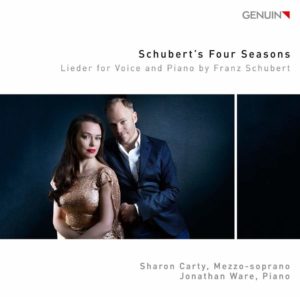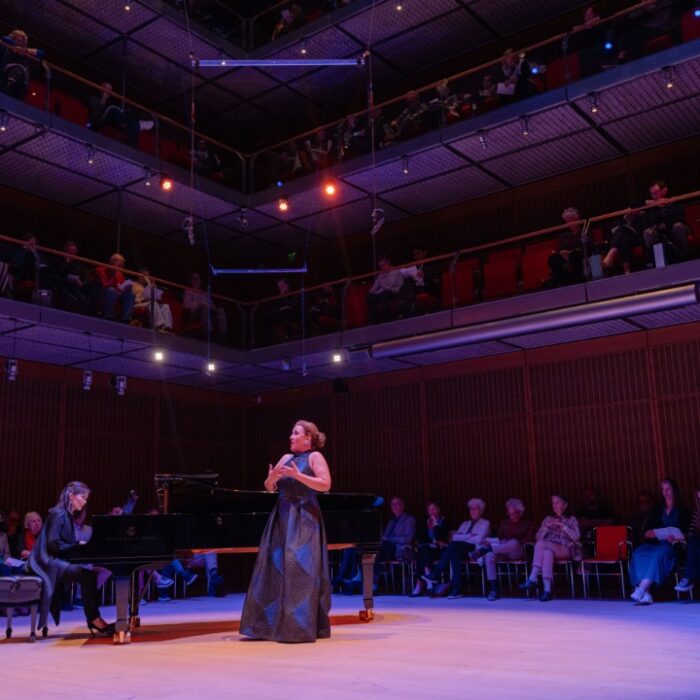
CD Review: Sharon Carty & Jonathan Ware’s ‘Schubert’s Four Seasons’
An Imaginative & Engaging Collection Beautifully Presented
By Alan Neilson(Photo: Frances Marshall )
The seasons have provided a rich source of inspiration for composers; Vivaldi’s violin concerti and Haydn’s oratorio spring to mind, but there are many others, such as Vaughan-Williams’ “Folk Songs of the Four Seasons,” and more recently Cage’s “The Four Seasons,” whilst Schumann’s “Spring” symphony and Schubert’s song cycle “Winterreise” focused on a particular season. They are apparently a near never-ending source of inspiration.
Mezzo-soprano Sharon Carty and pianist Jonathan Ware have now added to the list with a new disc entitled “Schubert’s Four Seasons.” It is not a cycle that Schubert himself conceived, but a selection of nine lieder each focusing on an aspect of a particular season, which have been brought together to produce a picture of the changing seasons, highlighting features of the natural world, and how they intersects with the moods, life cycle and reflections of human existence.
Nine lieder have been chosen: there are two relating to each season, followed by a concluding piece, “Klage der Ceres,” which is a representation of how the seasons came into being according to the greek myth of Ceres and Proserpine.
Klage der Ceres
“Klage der Ceres” (D. 323) written in 1816 to a text by Schiller would have made an excellent prologue to the “Four Seasons” but for some reason is has been tagged on to the end of the disc, making it appear as a makeweight. It also happens to be the longest piece, with a running time of 15 minutes and 37 seconds. Unlike all the other lieder, this one actually relates a dramatic story, largely told in the first person, thereby providing Carty with an excellent opportunity to display her ability as a storyteller.
Ceres laments the loss her daughter Proserpine, who has been dragged down to the Underworld by Pluto. Anxious and stricken with grief, Ceres, the goddess of corn, refuses to allow the crops to grow, and so it is that the Earth sinks into a deep winter. Eventually, Pluto relents and for six months of every year her daughter returns to the Earth and Ceres responds by reseeding the earth. So it is the seasons are born.
To the extent that “Klage der Ceres” has the momentum of a fast moving tale, it lends itself to, if not demands, an outwardly expressive, dramatic interpretation, which plays to Carty’s strengths.
It is a song full of emotional turmoil to which she responds sympathetically, engaging fully with its dramatic shifts. Listening to her interpretation one can hear Ceres’ anxiety and grief, reflective pain, her determination and hope and the eventual joy of reuniting with her daughter.
Her phrasing is beautifully woven to pick out the textual nuances, which are full of colorful and dynamic shadings, neatly placed accents and subtle ornamentations, her articulation is clear and exact. Ware’s accompaniment is never intrusive, but nor does it fade into the background, and thus simultaneously adds to its emotional power while providing the necessary support.
Spring
The first track “Viola” D. 786, written in 1823 to a text by Franz von Schober, tells the story of a single flower, a violet, which appears too early in the year and dies of loneliness and of winter’s final blasts. It is a song of sad emotions. In a poignant and heartfelt piece of singing, in which her phrasing is full of expressive intensity, Carty brings the song truly alive, and captures the despair of a life spent in isolation, separated from those they love. It is an engaging piece, rendered with the utmost charm and beautifully paced.
Goethe’s poem about Zeus’ abduction of a beautiful youth called Ganymede provides the text for the second piece, suitably entitled “Ganymede” (D 289), which Schubert completed in 1817.
Ganymede has been forced to serve as a cupbearer to Zeus, but in this lieder he celebrates the everlasting joys of spring. Ware’s lively and and sensitive interpretation provides a beautiful backdrop for Carty’s delightful rendition, in which her vocal coloring and optimistic lilt capture spring’s pleasures, with the call of the nightingale clearly pictured.
The piece ends with Ganymede ascending to the heavens into the lap of Zeus accompanied by Carty’s long soaring lines.
Summer
The two lieder selected for summer are “Der Sommernacht” D 289, to a text written in 1815 by Friedrich Gottlieb Klopstock, and “Romanze” D 797/3b from a suite of incidental music written for the stage work “Rosamunde” in 1823.
Both are short pieces which have an immediacy that are able to draw in the listener. “Der Sommernacht” is a reflective work, in which the narrator who is taking a walk in a forest as the light draws to a close and the moon shimmers over the woods, casts his mind back to his now deceased beloved.
It is piece composed of recitative phrases separated by pianistic interludes, the two conversing with each other, ending with a short arioso. Carty drapes her voice in a deep melancholy as she ponders the beauty of nature which the narrator can no longer share with his lover, which all changes in the arioso section as he recalls their shared experience, to which Carty responds with phrasing which is now tinged ever so lightly with a sense of peace.
“Romanze” is another melancholic song which once again takes place under the summer moonlight. In a fine presentation Carty’s evocative lilting voice is wonderfully supported by the nicely weighted chords of the piano.
Autumn
The moon makes yet another appearance in the first of the lieder selected for autumn, “An den Mond in einer Herbstnacht” D 614, to a text written in 1818 by Schreiber. It is a reflection on the transient nature of existence and the solace and hope which the autumn moon brings to young man who, now alone, ponders on its relationship to his life.
Backed by Ware’s carefully managed accompaniment, Carty produces a detailed and nuanced interpretation which captures the the young man’s meandering thoughts, while showing off her intelligently crafted phrasing, the beautiful timbre of her voice and subtly molded ornamentations.
Written in 1816 to a text by Johann Georg Jacobi “Litanie auf das Fest Allerseelen” D 343 is a litany for the souls that have passed away in peaceful and unhappy circumstances. The sheer simplicity of the piece belies its beauty; Carty caresses each line with such delicacy and feeling, allowing her voice to float across the underlying accompaniment, in what is a ravishing piece of singing.
Winter
Unsurprisingly, the two selections for winter are metaphors for old age. The first, “Greisengesang” D 778, written in 1823 to a text by Friedrich Rückert, contrasts the harsh winter with inner calm and contentment of a man facing the final years of his life.
Carty sings with a bright, clear, crisp precision, which successfully conjures up the frosty winter landscape, but always remains calm and in the final lines allows a degree of warmth to enter into the voice as the man is urged to shut out the winter and focus on his dreams.
The final piece, dating from 1828, “Der Winterabend” D 938 to a text by Karl Gottfried von Leitner provides the perfect song to finish the “Four Seasons.” This time an old man sits alone at the window looking out at a winter moon, thinking of his now deceased beloved. Carty’s rendition is calm, refined, and the passions are warmly drawn throughout. It ends with the sound of the piano fading into silent reflection, which would have also made the ideal ending to the disc.
Although the pieces were composed over the course of Schubert’s career, the idea of using the seasons as a framing device gives the disc a coherence which is much more satisfying than a simple unrelated collection of lieder. Moreover, the textual and musical sympathy that exists between the pieces provides a greater depth to the individual portraits.
This is a disc which confirms Carty as an accomplished lieder singer, in which the choice of pieces act as a showcase for her vocal qualities.
Carty sings with an open, rounded and mature sound, her voice is firm, secure, with a smooth even tone. It is also displays her keen musical intelligence; each lieder is subtly woven, with coloring, accenting and dynamic nuance all expertly employed so that the textual and musical meaning of each piece is at the forefront of the performance. Above all, it is an honest interpretation, faithful to the composer’s intentions.
One more notable feature of this disc is the rapport that exists between singer and pianist. There is a chemistry between them which allows each piece to develop with what appears to be a natural progression, there is nothing learned or superficial, rather they are responding sympathetically to each other’s strengths.
All in all, this is a fine CD. It is imaginative and well-executed, and successfully brings together a compilation of Schubert’s lieder which will delight the listener.




